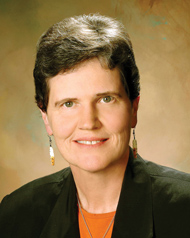View From the Administrator: Working Together to Prevent Suicide
By Pamela S. Hyde, J.D., SAMHSA Administrator
Suicide is one of our nation’s greatest public health problems and it’s largely preventable. New developments over the past decade are shedding light on ways everyone can help prevent suicide. Reflecting significant changes in the landscape, the Office of the Surgeon General and the National Action Alliance for Suicide Prevention recently released an updated National Strategy for Suicide Prevention. SAMHSA is proud to be part of the Action Alliance, a public-private organization that was created as a result of the first National Strategy, and applauds this important update.

In the decade since the first National Strategy was issued in 2001, the suicide prevention field, including SAMHSA, has made significant strides in suicide prevention. Accomplishments include the enactment of the Garrett Lee Smith Memorial Act (see SAMHSA News November/December 2007), which created the first significant federal grant program to states, tribes, territories, and institutions of higher education for youth and college suicide prevention efforts. Through these SAMHSA-managed grants, funds are used to enhance a range of behavioral health services and to provide training for students, families, faculty, staff, and communities.
Advancements also include the creation of the National Suicide Prevention Lifeline  , 1–800–273–TALK (8255), as well as collaborations with the Veterans Crisis Line. The SAMHSA-funded Suicide Prevention Resource Center (SPRC)
, 1–800–273–TALK (8255), as well as collaborations with the Veterans Crisis Line. The SAMHSA-funded Suicide Prevention Resource Center (SPRC)  advances the National Strategy by providing technical assistance, training, and materials to increase the knowledge and expertise of individuals serving people at risk for suicide. The SPRC also maintains databases of evidence-based programs and best practices.
advances the National Strategy by providing technical assistance, training, and materials to increase the knowledge and expertise of individuals serving people at risk for suicide. The SPRC also maintains databases of evidence-based programs and best practices.
The updated National Strategy highlights additional resources for preventing suicide today, such as using technology like social media and implementing better coordination of care among health care professionals. It recognizes that suicide is a complex issue that requires a comprehensive and coordinated approach. SAMHSA is committed to continuing its work with private organizations and federal departments such as the U.S. Department of Defense and U.S. Department of Veterans Affairs in order to provide states, territories, tribes, and communities with the resources they need to help prevent suicide.
I encourage everyone to read the National Strategy and learn about the many resources, programs, and tools available to help prevent suicide in your community. It is imperative that Americans work together to reach out to those at risk. Together, we can help prevent the pain that suicide brings to individuals, their loved ones, and entire communities.
— Pamela S. Hyde, J.D.
To read or download a copy of the National Strategy, visit www.samhsa.gov/nssp.
Click here for more suicide prevention resources